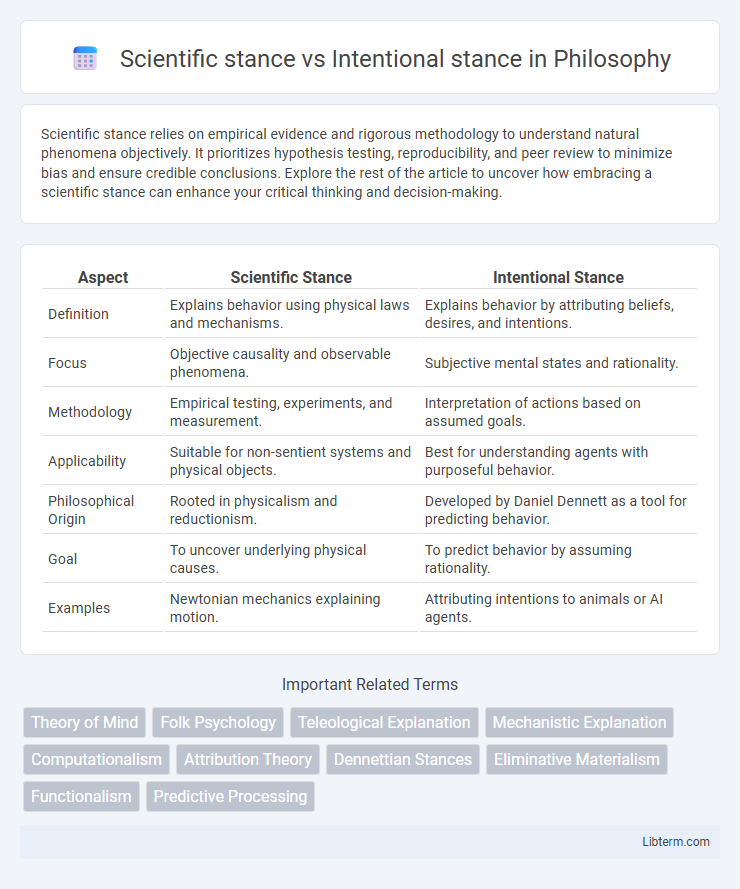Scientific stance relies on empirical evidence and rigorous methodology to understand natural phenomena objectively. It prioritizes hypothesis testing, reproducibility, and peer review to minimize bias and ensure credible conclusions. Explore the rest of the article to uncover how embracing a scientific stance can enhance your critical thinking and decision-making.
Table of Comparison
| Aspect | Scientific Stance | Intentional Stance |
|---|---|---|
| Definition | Explains behavior using physical laws and mechanisms. | Explains behavior by attributing beliefs, desires, and intentions. |
| Focus | Objective causality and observable phenomena. | Subjective mental states and rationality. |
| Methodology | Empirical testing, experiments, and measurement. | Interpretation of actions based on assumed goals. |
| Applicability | Suitable for non-sentient systems and physical objects. | Best for understanding agents with purposeful behavior. |
| Philosophical Origin | Rooted in physicalism and reductionism. | Developed by Daniel Dennett as a tool for predicting behavior. |
| Goal | To uncover underlying physical causes. | To predict behavior by assuming rationality. |
| Examples | Newtonian mechanics explaining motion. | Attributing intentions to animals or AI agents. |
Introduction to Scientific Stance and Intentional Stance
The scientific stance involves explaining phenomena through objective observation, empirical data, and natural laws, focusing on cause-and-effect relationships without attributing beliefs or desires. The intentional stance interprets behavior by ascribing mental states like beliefs, desires, or intentions to agents, treating them as rational actors to predict actions. Understanding the distinction between these approaches clarifies how explanations differ when analyzing physical systems versus cognitive agents.
Defining the Scientific Stance
The scientific stance emphasizes objective observation, empirical evidence, and testable hypotheses to understand natural phenomena, prioritizing causality and reproducibility. It relies on systematic experimentation and measurement to form conclusions independent of subjective interpretations or beliefs. This approach contrasts with the intentional stance, which interprets behavior by attributing beliefs, desires, and intentions to agents.
Understanding the Intentional Stance
Understanding the intentional stance involves interpreting the behavior of agents by attributing beliefs, desires, and rationality to predict their actions, as proposed by philosopher Daniel Dennett. This stance assumes that agents act purposefully to achieve specific goals, making it effective for explaining human behavior and social interactions. Unlike the scientific stance, which explains phenomena through objective physical laws and empirical data, the intentional stance relies on subjective mental states to provide meaningful insights into complex decision-making processes.
Historical Development of Both Stances
The scientific stance, rooted in the empirical methods of the Enlightenment and early modern science, emphasizes observation, hypothesis testing, and mechanical explanations dating back to figures like Galileo and Newton. The intentional stance, introduced by philosopher Daniel Dennett in the late 20th century, centers on interpreting behavior by attributing beliefs, desires, and rationality to agents, reflecting a shift toward understanding cognition and agency. Historically, the scientific stance provided the foundation for objective inquiry, while the intentional stance emerged as a complementary framework for explaining complex mental phenomena and social interactions.
Key Differences Between Scientific and Intentional Stances
The scientific stance explains phenomena through objective, measurable facts and causal laws, emphasizing empirical evidence and testability. In contrast, the intentional stance interprets behavior by attributing beliefs, desires, and intentions to agents, focusing on predictive understanding rather than causal explanation. Key differences include the scientific stance's reliance on physical laws versus the intentional stance's use of mental state ascriptions for behavioral predictions.
Applications of the Scientific Stance in Research
The scientific stance, rooted in empirical observation and testable hypotheses, drives advancements in fields such as physics, biology, and chemistry by enabling systematic experimentation and data analysis. This stance emphasizes objective measurement and reproducibility, facilitating the development of technologies ranging from medical diagnostics to environmental modeling. Research applications benefit from the scientific stance's rigorous approach to understanding natural phenomena, enhancing predictive accuracy and fostering innovation through evidence-based conclusions.
Intentional Stance in Psychology and Artificial Intelligence
The intentional stance in psychology and artificial intelligence involves interpreting behavior by attributing beliefs, desires, and intentions to agents, facilitating prediction and understanding of complex actions. This approach contrasts with the scientific stance, which relies on objective, mechanistic explanations grounded in physical processes and empirical data. In AI, adopting the intentional stance enhances human-computer interaction by enabling systems to model user goals and anticipate responses, improving adaptability and decision-making.
Advantages and Limitations of Each Stance
The scientific stance prioritizes objective observation and empirical evidence, offering advantages such as predictive accuracy and reliability in explaining natural phenomena, but it may struggle with subjective experiences and mental states. The intentional stance interprets behavior by attributing beliefs, desires, and intentions, enabling understanding of complex social interactions and cognitive processes, yet it risks anthropomorphism and lacks rigorous empirical validation. Balancing these stances allows deeper insights into both physical systems and mental agents, leveraging the strengths of empirical data and interpretative frameworks.
Debates and Criticisms in Philosophy of Mind
Debates in the philosophy of mind often center on the scientific stance, which relies on objective, third-person explanations rooted in physics and biology, versus the intentional stance, which interprets mental states through beliefs, desires, and rationality attributed to agents. Critics argue the scientific stance can be reductionist and overlook subjective experiences, while opponents of the intentional stance claim it risks anthropomorphizing non-human entities and lacks empirical rigor. Key discussions revolve around whether intentionality can be fully captured by scientific explanation or requires a distinct interpretive framework, highlighting tensions between physicalism and folk psychology.
Conclusion: Integrating Perspectives for Deeper Understanding
Scientific stance emphasizes objective analysis based on empirical data and causal mechanisms, while the intentional stance interprets behavior by attributing beliefs and desires to agents. Integrating these perspectives allows for a richer explanation that combines measurable phenomena with mental state attributions, enhancing predictive power and explanatory depth. This synthesis facilitates a comprehensive understanding of complex systems, bridging the gap between physical processes and intentional behavior.
Scientific stance Infographic

 libterm.com
libterm.com